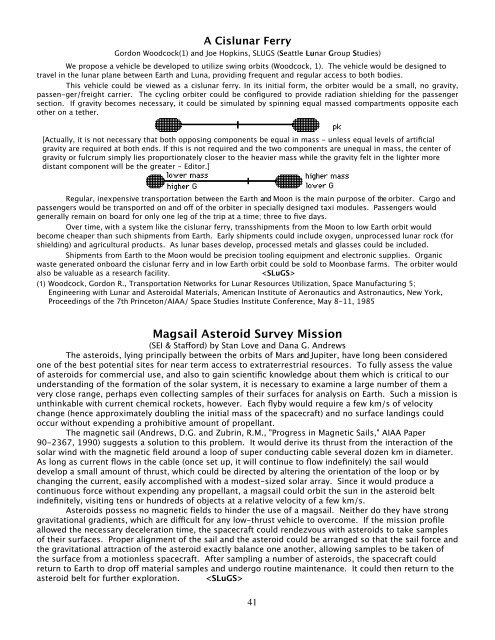Space Transportation - mmmt_transportation.pdf - Moon Society
Space Transportation - mmmt_transportation.pdf - Moon Society
Space Transportation - mmmt_transportation.pdf - Moon Society
You also want an ePaper? Increase the reach of your titles
YUMPU automatically turns print PDFs into web optimized ePapers that Google loves.
A Cislunar Ferry<br />
Gordon Woodcock(1) and Joe Hopkins, SLUGS (Seattle Lunar Group Studies)<br />
We propose a vehicle be developed to utilize swing orbits (Woodcock, 1). The vehicle would be designed to<br />
travel in the lunar plane between Earth and Luna, providing frequent and regular access to both bodies.<br />
This vehicle could be viewed as a cislunar ferry. In its initial form, the orbiter would be a small, no gravity,<br />
passen-ger/freight carrier. The cycling orbiter could be configured to provide radiation shielding for the passenger<br />
section. If gravity becomes necessary, it could be simulated by spinning equal massed compartments opposite each<br />
other on a tether.<br />
[Actually, it is not necessary that both opposing components be equal in mass - unless equal levels of artificial<br />
gravity are required at both ends. If this is not required and the two components are unequal in mass, the center of<br />
gravity or fulcrum simply lies proportionately closer to the heavier mass while the gravity felt in the lighter more<br />
distant component will be the greater - Editor.]<br />
Regular, inexpensive <strong>transportation</strong> between the Earth and <strong>Moon</strong> is the main purpose of the orbiter. Cargo and<br />
passengers would be transported on and off of the orbiter in specially designed taxi modules. Passengers would<br />
generally remain on board for only one leg of the trip at a time; three to five days.<br />
Over time, with a system like the cislunar ferry, transshipments from the <strong>Moon</strong> to low Earth orbit would<br />
become cheaper than such shipments from Earth. Early shipments could include oxygen, unprocessed lunar rock (for<br />
shielding) and agricultural products. As lunar bases develop, processed metals and glasses could be included.<br />
Shipments from Earth to the <strong>Moon</strong> would be precision tooling equipment and electronic supplies. Organic<br />
waste generated onboard the cislunar ferry and in low Earth orbit could be sold to <strong>Moon</strong>base farms. The orbiter would<br />
also be valuable as a research facility. <br />
(1) Woodcock, Gordon R., <strong>Transportation</strong> Networks for Lunar Resources Utilization, <strong>Space</strong> Manufacturing 5;<br />
Engineering with Lunar and Asteroidal Materials, American Institute of Aeronautics and Astronautics, New York,<br />
Proceedings of the 7th Princeton/AIAA/ <strong>Space</strong> Studies Institute Conference, May 8-11, 1985<br />
Magsail Asteroid Survey Mission<br />
(SEI & Stafford) by Stan Love and Dana G. Andrews<br />
The asteroids, lying principally between the orbits of Mars and Jupiter, have long been considered<br />
one of the best potential sites for near term access to extraterrestrial resources. To fully assess the value<br />
of asteroids for commercial use, and also to gain scientific knowledge about them which is critical to our<br />
understanding of the formation of the solar system, it is necessary to examine a large number of them a<br />
very close range, perhaps even collecting samples of their surfaces for analysis on Earth. Such a mission is<br />
unthinkable with current chemical rockets, however. Each flyby would require a few km/s of velocity<br />
change (hence approximately doubling the initial mass of the spacecraft) and no surface landings could<br />
occur without expending a prohibitive amount of propellant.<br />
The magnetic sail (Andrews, D.G. and Zubrin, R.M., "Progress in Magnetic Sails," AIAA Paper<br />
90-2367, 1990) suggests a solution to this problem. It would derive its thrust from the interaction of the<br />
solar wind with the magnetic field around a loop of super conducting cable several dozen km in diameter.<br />
As long as current flows in the cable (once set up, it will continue to flow indefinitely) the sail would<br />
develop a small amount of thrust, which could be directed by altering the orientation of the loop or by<br />
changing the current, easily accomplished with a modest-sized solar array. Since it would produce a<br />
continuous force without expending any propellant, a magsail could orbit the sun in the asteroid belt<br />
indefinitely, visiting tens or hundreds of objects at a relative velocity of a few km/s.<br />
Asteroids possess no magnetic fields to hinder the use of a magsail. Neither do they have strong<br />
gravitational gradients, which are difficult for any low-thrust vehicle to overcome. If the mission profile<br />
allowed the necessary deceleration time, the spacecraft could rendezvous with asteroids to take samples<br />
of their surfaces. Proper alignment of the sail and the asteroid could be arranged so that the sail force and<br />
the gravitational attraction of the asteroid exactly balance one another, allowing samples to be taken of<br />
the surface from a motionless spacecraft. After sampling a number of asteroids, the spacecraft could<br />
return to Earth to drop off material samples and undergo routine maintenance. It could then return to the<br />
asteroid belt for further exploration. <br />
41















